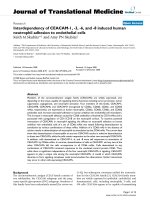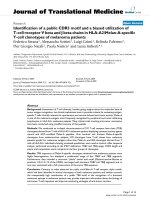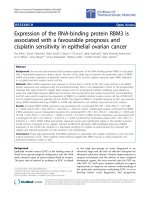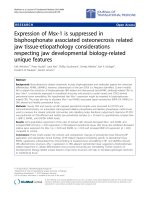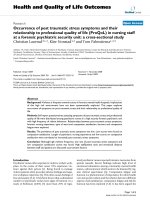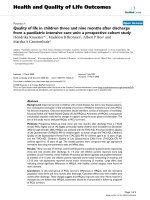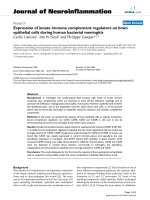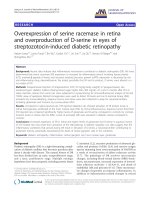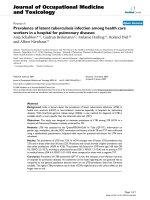Báo cáo hóa học: " Expression of HIV receptors, alternate receptors and co-receptors on tonsillar epithelium: implications for HIV binding and primary oral infection" doc
Bạn đang xem bản rút gọn của tài liệu. Xem và tải ngay bản đầy đủ của tài liệu tại đây (3.17 MB, 13 trang )
BioMed Central
Page 1 of 13
(page number not for citation purposes)
Virology Journal
Open Access
Research
Expression of HIV receptors, alternate receptors and co-receptors
on tonsillar epithelium: implications for HIV binding and primary
oral infection
Renu B Kumar
1,2
, Diane M Maher
1
, Mark C Herzberg
2
and Peter J Southern*
1
Address:
1
Department of Microbiology, University of Minnesota, Minneapolis, MN 55455, USA and
2
Department of Diagnostic and Biological
Sciences and the Mucosal and Vaccine Research Center, University of Minnesota, Minneapolis, MN 55455, USA
Email: Renu B Kumar - ; Diane M Maher - ; Mark C Herzberg - ;
Peter J Southern* -
* Corresponding author
Abstract
Background: Primary HIV infection can develop from exposure to HIV in the oral cavity. In
previous studies, we have documented rapid and extensive binding of HIV virions in seminal plasma
to intact mucosal surfaces of the palatine tonsil and also found that virions readily penetrated
beneath the tissue surfaces. As one approach to understand the molecular interactions that
support HIV virion binding to human mucosal surfaces, we have examined the distribution of the
primary HIV receptor CD4, the alternate HIV receptors heparan sulfate proteoglycan (HS) and
galactosyl ceramide (GalCer) and the co-receptors CXCR4 and CCR5 in palatine tonsil.
Results: Only HS was widely expressed on the surface of stratified squamous epithelium. In
contrast, HS, GalCer, CXCR4 and CCR5 were all expressed on the reticulated epithelium lining
the tonsillar crypts. We have observed extensive variability, both across tissue sections from any
tonsil and between tonsils, in the distribution of epithelial cells expressing either CXCR4 or CCR5
in the basal and suprabasal layers of stratified epithelium. The general expression patterns of
CXCR4, CCR5 and HS were similar in palatine tonsil from children and adults (age range 3–20).
We have also noted the presence of small clusters of lymphocytes, including CD4
+
T cells within
stratified epithelium and located precisely at the mucosal surfaces. CD4
+
T cells in these locations
would be immediately accessible to HIV virions.
Conclusion: In total, the likelihood of oral HIV transmission will be determined by macro and
micro tissue architecture, cell surface expression patterns of key molecules that may bind HIV and
the specific properties of the infectious inoculum.
Background
Oral exposure to HIV infectivity is known to occur in
mother-to-infant transmission by nursing [1-3] and for
participants in receptive oral intercourse [4-7]. HIV viri-
ons and/or HIV infected cells are shed in body fluid
released by the donor and mucosal surfaces in the oral
cavity of the recipient are transiently coated with HIV
infectivity. Many different mechanisms exist to protect
mucosal surfaces from HIV infection in the oral cavity
[8,9] but if the epithelial barrier is damaged or if virions
Published: 06 April 2006
Virology Journal2006, 3:25 doi:10.1186/1743-422X-3-25
Received: 04 October 2005
Accepted: 06 April 2006
This article is available from: />© 2006Kumar et al; licensee BioMed Central Ltd.
This is an Open Access article distributed under the terms of the Creative Commons Attribution License ( />),
which permits unrestricted use, distribution, and reproduction in any medium, provided the original work is properly cited.
Virology Journal 2006, 3:25 />Page 2 of 13
(page number not for citation purposes)
invade the epithelial cell layers then infectious HIV viri-
ons may readily come into contact with susceptible CD4
+
T cells [10]. Several studies using the simian immunodefi-
ciency virus (SIV)/rhesus macaque model have estab-
lished that atraumatic oral SIV inoculation can result in
primary SIV infection in palatine tonsil, followed rapidly
by systemic SIV infection [11-14]. Direct analysis of tissue
from HIV-infected patients has also implicated palatine
tonsil as a reservoir and replication site for HIV [15-17]. In
an attempt to gain further insight into the process of oral
transmission, we and others have created ex vivo organ cul-
ture systems with human palatine tonsil that recapitulate
HIV exposure to varying extents [10,18-21]. These studies
have provided valuable new information concerning the
cellular and molecular events that support oral HIV trans-
mission but many fundamental questions remain unre-
solved.
The external surface of the human palatine tonsil is prima-
rily covered by a stratified squamous epithelium where
the most external terminally differentiated cells are con-
tinually sloughed away and replaced by proliferation of
cells displaced upwards from the basal cell layer. In con-
trast to the proximal oral mucosa, the palatine tonsil sur-
face is notable for the presence of openings that provide
access into the tonsillar crypts. The surfaces of the crypts
are lined by reticulated epithelium and the actual barrier
between the lumen of the crypt and intraepithelial lym-
phocytes may only be one epithelial cell layer thick. The
unique cellular composition of reticulated epithelium,
where epithelial cells, leukocytes and stromal cells are all
situated in close proximity, has been associated with the
ongoing process of antigen sampling in the oral cavity
[22,23]. In the rabbit [24], there is direct evidence for the
presence in tonsillar crypts of M-like cells that correspond
to the M (Microfold) cells found overlying accumulations
of lymphoid cells (Peyer's patches) in the intestine but the
presence of M cells in the human palatine tonsil has not
been confirmed definitively [25,26]. In the context of oral
HIV transmission, the cellular composition and microar-
chitecture of the mucosal epithelial surfaces can be pro-
jected to have a major impact on whether exposure to HIV
will actually progress to the establishment of primary HIV
infection in the recipient.
In HIV/AIDS patients, the vast majority of the HIV infec-
tion is confined to the CD4
+
subset of T cells in lymphoid
tissues [15,27,28] and the CD4 molecule was identified
more than twenty years ago as the primary receptor for
HIV infection [29]. In subsequent studies, a connection
was established between HIV infection and virus recogni-
tion of co-receptors expressed on the target cell surface.
The principal co-receptors, CCR5 and CXCR4, like the
CD4 primary HIV receptor, are normal T cell surface pro-
teins with key roles in immune signaling and T cell func-
tion, as reviewed in Berger et al. [30]. Epithelial cells that
are susceptible to HIV infection have been reported to
express CXCR4 and CCR5 [31,32] but other studies have
not succeeded in establishing HIV infection in cervical
and prostate epithelial cells [33]. In a number of cases,
however, HIV infection has been detected in cells with low
to undetectable levels of CD4 expression and these obser-
vations prompted a search for alternate primary HIV
receptors. To date, heparan sulfate proteoglycan (HS) and
galactosyl ceramide (GalCer) have been identified as cell
surface macromolecules that can support HIV infection in
the absence of CD4 recognition by gp120 projecting from
the envelope of HIV virions [34-36]. Additional interac-
tions between virions and mucosal surfaces may be sup-
ported by host cell surface components that are routinely
incorporated into HIV envelopes [37,38]. For example,
the presence of ICAM-1 on the surface of HIV virions
allows recognition by the physiological receptor, LFA-1,
expressed on the target cell surface [39,40]. At the other
extreme, binding of retrovirus particles to target cells has
been demonstrated to occur in the complete absence of
virus envelope constituents [41,42]. It is therefore appar-
ent that a spectrum of interactions can occur between HIV
virions and exposed mucosal surfaces and that both the
properties of the inoculum (cell free HIV virions and/or
cell associated infectivity in the form of HIV-infected
cells) and the characteristics of the exposed surface will
contribute to the overall susceptibility to HIV infection. In
this study, we set out to document epithelial cell expres-
sion patterns for key cell surface molecules, implicated
directly and indirectly in HIV virion binding to mucosal
surfaces to account for the extensive binding of HIV viri-
ons to human palatine tonsil that we have previously
reported.
Results
Immunocytochemical definition of epithelial cell surfaces
in human palatine tonsil
Antibodies directed against representative epithelial cell
antigens were used as internal controls to establish the
specificity of the immunocytochemical staining proce-
dures for the panel of tonsils studied. Epithelial cells in
stratified squamous epithelium and cryptal epithelium
were identified with a polyclonal rabbit anti-cytokeratin
antibody (Figure 1a, b). Epithelial cells were independ-
ently detected with a mouse monoclonal antibody
directed against Hsp27 ([43], Table 1). The anti-Hsp27
antibody also bound to endothelial cells in all tonsil sec-
tions and a subset of T cells ([44], Table 1). A polyclonal
antibody directed against interleukin-8 (IL-8) was used to
evaluate the activation status of epithelial cells [45,46]
and a broad distribution of positive epithelial cells was
observed in both stratified squamous epithelium and
reticulated epithelium (Table 1). In addition, staining of a
subset of T cells, randomly distributed throughout the T
Virology Journal 2006, 3:25 />Page 3 of 13
(page number not for citation purposes)
Immunocytochemical detection of cell surface macromolecules expressed on stratified squamous epithelium and reticulated cryptal epithelium in human palatine tonsilFigure 1
Immunocytochemical detection of cell surface macromolecules expressed on stratified squamous epithelium and reticulated
cryptal epithelium in human palatine tonsil. Tissue sections were incubated with primary antibodies as indicated below. Positive
cells were identified with biotinylated secondary antibodies and streptavidin-peroxidase conjugates and are stained brown. All
sections were counterstained with hematoxylin. a: cytokeratin-stratified squamous epithelium; b: cytokeratin-cryptal epithe-
lium; c: control mouse antibody; d: HS; e: GalCer-cryptal epithelium; f: S100-dendritic cell marker; g: CD3; h: CXCR4; i: CCR5;
j: CXCR4 – showing variability in the distribution of CXCR4 positive cells and the reduced thickness of stratified epithelium
overlying a follicle at the lower left side. Note that in this large stretch of epithelium, an occasional CXCR4
+
cell may be a den-
dritic cell but based on Fig 1f, the overall abundance of dendritic cell is very low. Original magnification a-i: ×400; j: ×100.
Virology Journal 2006, 3:25 />Page 4 of 13
(page number not for citation purposes)
cell zone was consistently observed with the anti-IL-8
antibody (Table 1).
We also examined the distribution of ICAM-1 and LFA-1
on tonsil epithelial surfaces because this ligand/receptor
interaction has been linked to HIV virion binding to cell
surfaces [37,47]. ICAM-1 expression was localized exclu-
sively to the reticulated cryptal epithelium where the pos-
itive cell populations included epithelial cells,
lymphocytes and endothelial cells. No ICAM-1 expression
was detected on or within stratified squamous epithelium.
Only weak staining was observed in reticulated epithe-
lium with an antibody directed against LFA-1 (data not
shown).
Expression of the alternate HIV receptors heparan sulfate
proteoglycan and galactosyl ceramide
HIV attachment to cell surfaces is known to involve recog-
nition of proteoglycans that are widely distributed on the
surfaces of different cell types [34,35,42]. We detected
expression of HS on all cell layers comprising tonsillar
stratified epithelium, although in many areas we noted
elevated HS expression in the suprabasal layers of squa-
mous epithelial cells (Figure 1c, d, Table 1). Within tonsil-
lar crypts, the entire epithelial surface was lined with cells
expressing HS. Epithelial cells expressing GalCer were
detected within the tonsillar crypts (Figure 1e) but there
was extensive variability between tonsil donors.
Cellular invasion of stratified squamous epithelium
In addition to the prototypical content of epithelial cells
in varying stages of differentiation, we routinely observed
migrating dendritic cells (DC), macrophages and small
foci of invading T cells within stratified squamous epithe-
lium. The numbers and distribution of DC, macrophages
and T cells were highly variable across a stretch of strati-
fied epithelium (Figure 1f, g, data not shown for macro-
phages) but each of these cell types could be detected
within stratified epithelium for all of the tonsils exam-
ined.
Expression of HIV co-receptors CXCR4 and CCR5
Several previous studies have reported expression of the
principal HIV co-receptors, CXCR4 and CCR5, on cul-
tured epithelial cells [32,48,49] and that oral epithelial
cells are susceptible to HIV infection in vitro [31,50]. A
detailed evaluation by fluorescence activated cell sorting
(FACS) of co-receptor expression on tonsil cell suspen-
sions provided valuable information relating to lym-
phocyte populations [51] but, by gating on populations
of single cells of defined size, this study would probably
have excluded epithelial cells. We therefore set out to
establish expression profiles for CXCR4 and CCR5 on ton-
sillar epithelial surfaces using palatine tonsil sections. Epi-
thelial cells expressing either CXCR4 or CCR5 were
detected in the basal and suprabasal layers of stratified
squamous epithelium (Figure 1h, i) but there was wide
variability in the numbers of positive cells across a contin-
uous stretch of stratified epithelium (Figure 1j). Given the
observed low frequency of dendritic cells (Fig 1f), which
also may express CXCR4 and/or CCR5 [52,53] we con-
cluded that the co-receptor positive cells could not be
explained in terms of dendritic cells within the stratified
squamous epithelium. This point was explored directly in
Table 1: Qualitative immunocytochemical analysis of key cell surface macromolecules expressed on human palatine tonsil.
Tonsil Age CXCR4 CCR5 HS CD4 IL-8 Hsp27
SE CE T SE CE T SE CE T SE CE T SE CE T SE CE T
13 Fi+ii+i++ + i +i++ -
24 Fi+ii+i++ + + +i++ -
35 Fi+ii+i++ + i +i++ i
46 Mi+ii+i++ + i +i++ i
515i+ii+i++ + i +i++ i
617i+ii+i++ + + +i++ -
717 Fi+ii+i++ + + +i++ i
8a18 Fi+ii+i++ + + +i++ -
8b18 Fi+ii+i++ + + +i++ -
920 Fi+ii+i++ + + +i++ i
Frequency 9/9i 9/9+ 9/9i 9/9i 9/9+ 9/9i 9/9+ 9/9+ 9/9- 9/9- 9/9- 9/9+ 4/9i 5/9+ 9/9+ 9/9i 9/9+ 9/9+ 5/9i 0/9+
SE: stratified squamous epithelium; CE: cryptal epithelium; T: T cells; +: uniform strong positive expression; i: intermittent strong positive
expression; -: no detectable expression. SE and CE were strongly and uniformly positive with a polyclonal antibody to cytokeratins; there was no
detectable expression of cytokeratins in T cell populations (data not shown). Complete T cell populations were identified with anti-CD3 and most
of the T cells were CD45RO positive (data not shown). Results for 8a and 8b were obtained from two independent tissue blocks derived from the
same piece of tonsil. Specific staining conditions and optimized antibody dilutions are presented in Methods. In the "Age" column, M and F refer to
male and female respectively, where known.
Virology Journal 2006, 3:25 />Page 5 of 13
(page number not for citation purposes)
T cell distribution in proximity to the luminal surface of human palatine tonsilFigure 2
T cell distribution in proximity to the luminal surface of human palatine tonsil. Tissue sections were incubated with primary
antibodies as indicated below. Positive cells are stained brown. Sections were counterstained with hematoxylin. a: CD3; b:
CD4 – large irregular shaped CD4
+
cells within follicles are macrophages; c: CD8; d: CD3; e: CD4; f: CD8 – d, e and f repre-
sent enlargements of the regions enclosed within boxes in a, b and c respectively; g: H&E staining of tonsillar epithelium; h:
enlargement of region enclosed within the box in g; i; independent tonsil section stained with H&E to show surface lym-
phocytes. Original magnification a, b, c, g: ×100; d, e, f, h, i: ×400.
Virology Journal 2006, 3:25 />Page 6 of 13
(page number not for citation purposes)
double labeling experiments (see below). Within the ton-
sillar crypts, the reticulated epithelium showed extensive
expression of CXCR4 and CCR5. The general characteris-
tics of CXCR4 and CCR5 expression by epithelial cells
were consistent for tonsils obtained from nine different
subjects, representing tissue donors 3–20 years old (Table
1).
Distribution of T cell subsets in human palatine tonsil
In the course of processing tonsil sections with antibodies
to CXCR4 and CCR5, we identified T cell subsets that
expressed these surface antigens. Co-receptor positive T
cells were principally detected in the T cell zones in pala-
tine tonsil (extrafollicular areas). Systematic analysis of T
cell distribution was performed with a panel of T cell spe-
cific antibodies: CD3 (marker for all T cell subsets), CD4
(helper T cells and macrophages; note the absence of any
detectable CD4 expression on epithelial cells), CD8 (cyto-
lytic T cells; Figure 2a–f, Table 1). Both CD4 and CD8 pos-
itive T cells were located primarily in extrafollicular areas,
and the majority of these T cells expressed the CD45RO
activation marker (data not shown). Some T cells, pre-
Double label immunofluorescence detection of CXCR4 or CCR5 co-receptor positive T cells at tonsillar epithelial surfacesFigure 3
Double label immunofluorescence detection of CXCR4 or CCR5 co-receptor positive T cells at tonsillar epithelial surfaces.
Thin sections were incubated with primary antibodies and species-specific fluorescently conjugated secondary antibodies as
indicated. All sections were stained with DAPI (blue) to identify cell nuclei. a: CD3 (green) + CCR5 (red): DAPI overlay; b:
CD3 (green) + CCR5 (red): no DAPI overlay; c: enlargement of the region enclosed in the box in b; d: CD3 (green) + CXCR4
(red): DAPI overlay; e: CD3 (green) + CXCR4 (red): no DAPI overlay; f: enlargement of the region enclosed in the box in e.
Cells that are positive for both markers appear yellow; a-c depict stratified squamous epithelium, d-f depict reticulated cryptal
epithelium. Original magnification a, b, d, e: ×100.
Virology Journal 2006, 3:25 />Page 7 of 13
(page number not for citation purposes)
dominantly CD4
+
cells, were consistently detected within
B cell rich follicular structures, as would be expected in
lymphoid tissue involved with ongoing immune
responses (Figure 2b, c). Another indicator of immune
activation in palatine tonsil was revealed by the identifica-
tion of clusters of T cells that had invaded the basal and
suprabasal layers of stratified epithelium. These invading
cells were a mix of approximately 25% CD4
+
and 75%
CD8
+
T cells, with some of these T cells expressing either
CXCR4 or CCR5. A series of double label immunofluores-
cence experiments were performed to confirm that tonsil-
lar stratified squamous epithelium contained both CD3
+
CXCR4
+
or CCR5
+
T cells (Figure 3) and cytokeratin
+
CXCR4
+
or CCR5
+
epithelial cells (data not shown).
In addition to finding CD4
+
and CD8
+
T cells within epi-
thelial layers, we also detected T cells at the luminal sur-
face of otherwise undisturbed stratified squamous
tonsillar epithelium. Retrospective analysis of representa-
tive hematoxylin and eosin (H&E) stained slides from
randomly selected tonsils indicated that equivalent sur-
face accumulations of T cells could be found in 21 of 30
tonsil samples examined (Figure 2g–i). We were very con-
cerned about artifactual trapping of lymphocytes at the
tissue surface either because the tissue pieces had been
fixed while still covered with a film of blood or because of
relocation of tissue fragments during sectioning. How-
ever, the surface lymphocytes appeared to be enclosed
within a membrane and in continuous contact with the
underlying epithelial cells, suggesting that the lym-
phocytes had been naturally present on the tonsil surface
prior to the surgery. The visual absence of erythrocytes in
these surface accumulations of lymphocytes provided fur-
ther support for a potentially significant biological role for
these surface T cells.
Epithelial damage and repair in ex vivo tonsil organ culture and HIV infection of tonsil cellsFigure 4
Epithelial damage and repair in ex vivo tonsil organ culture and HIV infection of tonsil cells. Small randomly cut pieces of tonsil
tissue reacquired an epithelial cell coating during organ culture. Thin sections were incubated with primary antibodies and spe-
cies-specific conjugated secondary antibodies as indicated. a: CCR5; b: CXCR4; c: CCR5 (red) plus CXCR4 (green), cells that
are positive for both fluorescent markers appear yellow. Original magnification a, b, c: ×200. Tonsil cell suspensions were
infected with HIV 96–480 patient isolate virus stock, then cells were spotted onto glass slides for immunocytochemical detec-
tion of HIV p24 gag: d: day 0, prior to infection; e: day 5; and f: day 10 after infection; g: enlargement from f. HIV infected cells
are stained brown; cell nuclei were identified with a hematoxylin counterstain. Original magnification d, e, f: ×100; g: ×400.
Virology Journal 2006, 3:25 />Page 8 of 13
(page number not for citation purposes)
Epithelial damage and HIV infection of tonsil cells
In an extreme representation of tonsil damage that would
involve complete removal of the protective epithelium,
small cut pieces of tonsil tissue were maintained in organ
culture and infected with HIV [21]. As noted previously,
cut pieces of tonsil in organ culture supported the sponta-
neous proliferation of epithelial cells and consistently
produced an epithelial cell coating, two-four cell layers
thick that enclosed the tonsil pieces [19,21]. The epithelial
character of the surface coating of cells was confirmed by
strong positive staining with antibodies directed against
cytokeratins (data not shown). These newly proliferated
epithelial cells expressed high levels of CXCR4 and CCR5,
and analysis of adjacent tissue sections indicated that
many of these epithelial cells could be expressing both
CXCR4 and CCR5 (Figure 4a, b). Co-expression of CXCR4
and CCR5 was confirmed by double immunofluorescence
labeling (Figure 4c). These surface epithelial cells did not
support productive HIV infection, as judged by immuno-
cytochemical staining for HIV p24 gag. However, high-
level epithelial cell expression of CXCR4 and CCR5 may
be important in the context of HIV virion binding to
mucosal surfaces that have been repaired after physical
damage.
HIV exposure and infection at a damaged tonsil tissue sur-
face was also simulated using cell suspensions obtained
by mechanical disruption of tonsil pieces. These cell sus-
pensions comprised approximately equal mixtures of B
and T cells, as judged by immunocytochemical staining of
fixed cell spots (data not shown). Experimental exposure
of tonsil cell suspensions to cell-free HIV96-480 virions (a
primary patient isolate of HIV with dual tropic properties
[21]) led to the establishment of widespread HIV infec-
tion and multinucleated giant cells were readily visible at
day 10 (Figure 4d–g). In this experiment, which equates to
Schematic representation of cell surface macromolecules and migrating cells implicated in HIV binding and uptakeFigure 5
Schematic representation of cell surface macromolecules and migrating cells implicated in HIV binding and uptake. The inset to
the left shows a low magnification photomicrograph of a thin section cut through the external surface of human palatine tonsil
(H&E; original magnification: ×40). Most of the external surface of the tonsil is protected by stratified squamous epithelium but
there is an abrupt transition to reticulated epithelium at the entrance to a crypt. Cell surface molecules that may contribute to
HIV virion binding and the cell types expressing these target molecules are depicted in the diagrammatic representations of
stratified squamous epithelium and reticulated cryptal epithelium.
Virology Journal 2006, 3:25 />Page 9 of 13
(page number not for citation purposes)
complete removal of the epithelial surface, tonsillar lym-
phocytes were directly accessible to HIV virions and a
spreading productive infection was readily established.
Discussion
We have recently developed a quantitative HIV virion
binding assay that documents rapid and extensive binding
of HIV virions in seminal plasma to intact mucosal sur-
faces [10,54]. In the course of these studies, we realized
that both micro and macro structural heterogeneity were
commonplace at the surface of randomly selected palatine
tonsil samples and that surface structural aberrations
could have a profound impact on susceptibility to all
microbial infections, including HIV. The current study
was designed to investigate the molecular basis for HIV
virion binding to intact mucosal surfaces by characteriz-
ing the expression patterns in palatine tonsil for HIV
receptors, HIV co-receptors and other cell surface markers
that have been implicated in HIV infection. Based on a
comprehensive interpretation of the expression patterns
revealed in this study, we conclude that multiple distinct
interactions may be supporting HIV virion binding to
mucosal surfaces and that the specific molecules involved
with binding at any particular site will be directly deter-
mined by the precise anatomical location of that site. For
example, we have now recognized there are more poten-
tial interactions that could support virion binding to retic-
ulated epithelium in the tonsillar crypts than would be
immediately available to support virion binding to the
luminal surface of stratified squamous epithelium (Figure
5).
When virions in seminal plasma are deposited onto an
intact luminal surface of stratified squamous epithelium,
the most likely interaction leading to stable binding
would appear to involve recognition of HS. If, as has been
observed in our previous work [10], virions can penetrate
beneath the epithelial surface then there would be the
possibility to bind to dendritic cells (Figure 1f, [55-57]) or
macrophages present within the epithelium, to bind to
CD4
+
T cells expressing either CXCR4 or CCR5 (Figures
1g, 2 and 3) that have invaded the epithelium or even to
bind to epithelial cells expressing CXCR4 or CCR5 (Fig-
ures 1h, i, j, 3 and 4). It is also conceivable that an initial
binding event to HS at the luminal surface precedes a cell
uptake mechanism (endocytosis or transcytosis) or para-
cellular transport, allowing the virions to penetrate
beneath the luminal surface. These potential interactions
involving multiple cell surface macromolecules expressed
on several different cell types are presented diagrammati-
cally in Figure 5. There appears to be a large element of
chance involved with HIV transmission across mucosal
surfaces because epidemiological surveys have revealed
that 1 in 200–1000 exposure events are typically associ-
ated with male to female heterosexual transmission of
HIV [58,59]. This relatively low rate of transmission may
be explained, at least in part, by the requirement for ran-
dom encounters between HIV virions and dendritic cells,
macrophages or CD4
+
T cells that are transiently located in
proximity to the exposed mucosal surfaces. The connec-
tion between "chance" and oral HIV infection is also
influenced by the morphological characteristics of the
exposed surface, including heterogeneity in the thickness
of the epithelium, epithelial damage and surface remode-
ling as a consequence of chronic tonsillar inflammation.
In many of the tissue samples examined for this study we
detected accumulations of lymphocytes, including CD4
+
T
cells at the luminal surface of stratified squamous epithe-
lium (Figure 2g–i). This would imply that virion binding
and even primary HIV infection could be initiated at, or
very close to the surface of palatine tonsil. It is not neces-
sarily clear how an infection initiated in this manner
might spread to other CD4
+
T cells but migrating dendritic
cells or macrophages could carry the infection back
towards the large T cell populations in extrafollicular
areas. It is also important to emphasize the variability we
have observed in the number of epithelial cell layers that
comprise the stratified squamous epithelial barrier (Fig-
ure 1j) because contact with large CD4
+
T cells pools can
be projected to occur much more readily if the distance to
be traversed by HIV infectivity is reduced.
If virions in seminal plasma enter into crypts then at least
five surface macromolecules – HS, GalCer, CXCR4, CCR5,
and ICAM-1 expressed on epithelial cells represent poten-
tial binding sites for initial interactions with virions (Fig-
ure 5). Furthermore, in reflection of the diverse cell
composition of reticulated epithelium, it is likely that
CD4
+
T cells will be located within 1–2 cell layers of the
luminal surface throughout the crypts (Figure 3d–f). The
tonsillar crypts have been linked with antigen sampling in
the oral cavity and it is conceivable that transcytosis by
cryptal epithelial cells with "M-like" properties could
place HIV virions in immediate proximity to intraepithe-
lial CD4
+
T cells [22,60]. This mechanism of HIV virion
uptake would gain substantial credibility with the recog-
nition and functional characterization of M cells in the
human palatine tonsil.
The variability observed in the distribution of epithelial
cells that expressed CXCR4 and CCR5 within stratified
squamous epithelium was unexpected. These findings
suggest that surface expression of CXCR4 and CCR5 in
epithelial cells may correspond to an early stage in a dif-
ferentiation pathway but the absence of uniform expres-
sion in the suprabasal cell layers remains unexplained. It
is interesting to note that similar variability in co-receptor
expression patterns was found in populations of primary
human epithelial cells, grown out from pieces of palatine
Virology Journal 2006, 3:25 />Page 10 of 13
(page number not for citation purposes)
tonsil (data not shown). The overall variability revealed in
our analyses of epithelial surfaces in palatine tonsil may
indicate that the epithelium is in a continuous state of
dynamic flux and that the expression patterns of epithelial
cell surface molecules are likely to reflect localized influ-
ences including repair from physical damage, invasion by
inflammatory cells and tissue remodeling as tonsillar lym-
phocyte populations expand and contract. Because the tis-
sue used in these experiments was removed from patients
with tonsillitis, the palatine tonsils analyzed cannot be
regarded as strictly normal. However, tonsillar inflamma-
tion in the form of a "sore throat" is not uncommon and
there is growing recognition of the connection between
pre-existing infections and increased susceptibility to
exogenous infection [61].
Conclusion
For the cell surface markers examined in this study, no dif-
ferences were identified for tissue donors ranging from 3–
20 years old. However, we have recognized that structural
and functional variability are commonplace at the surface
of surgically removed tonsils. Our results reveal a complex
expression pattern for HIV receptors, co-receptors, surface
adhesion molecules and alternate receptors in stratified
squamous epithelium and cryptal reticulated epithelium
that individually or collectively could support extensive
and stable HIV virion binding. Further insight, leading to
the development of a pool of antagonists that effectively
blocks virion binding to mucosal surfaces could contrib-
ute significantly to a reduction in current rates of HIV
transmission.
Methods
Tissue collection and processing
Palatine tonsil tissue samples were obtained from routine
tonsillectomies performed at the University of Minnesota
Medical Center. Tissue donors, or the legal guardian of a
child, provided informed consent prior to initiation of the
surgery and the protocol to obtain tissue samples had
received full IRB approval. All tissues examined in this
study were collected from patients with tonsillitis. Tissue
pieces were fixed in Streck Tissue Fixative (STF; Streck Lab-
oratories, La Vista, NE) within 1–3 hours of completion of
the surgery and then processed by standard methods for
paraffin embedding and microtome sectioning. In some
instances, tissue pieces were snap frozen in liquid nitro-
gen for cryostat sectioning. Any tissue with gross macro-
scopic abnormality was excluded from this study.
Immunocytochemistry and immunofluorescence detection
procedures
Single label immunocytochemistry was performed on
paraffin embedded sections (5 µm) and specific antibody
binding was detected with biotinylated secondary anti-
bodies and streptavidin-peroxidase conjugates (ABC Sys-
tem; Vector Diagnostics, Burlingame, CA), as described
previously [10,21]. Tissues were counterstained with
hematoxylin (Sigma-Aldrich, St. Louis, MO) and
mounted in Permount (Fisher Scientific, Fair Lawn, NJ).
The specificity of staining for individual antibodies was
confirmed using either an unrelated isotype control anti-
body or secondary antibody alone. For some antibodies,
where the target epitope was known to be destroyed by
paraffin embedding, expression profiles were determined
by staining frozen tonsil sections that were fixed in STF
immediately prior to use.
Double label detection of target antigens was performed
by immunofluorescence staining of paraffin embedded or
frozen tissue sections, taking into account the properties
of the primary antibodies. In short, after antigen retrieval
by citrate buffer, tissue sections were blocked with TNB
[0.1 M Tris. HCl pH7.5, 0.15 M NaCl, 0.5% w/v Dupont
blocking reagent (Perkin Elmer, Boston, MA)] and 1.5%
horse serum followed by overnight incubation with pri-
mary antibody at 4°C. Tissue sections were then washed,
reblocked and incubated with appropriate secondary anti-
body (Alexa 568-anti mouse or Alexa 488-anti rabbit con-
jugates; Molecular Probes Inc, Eugene, OR) for 1 h at
room temperature. After dehydration through graded
alcohols, the sections were cleared with methyl salicylate
(Sigma-Aldrich), mounted in DEPEX (Electron Micro-
scopic Sciences, Ft. Washington, PA) and stored at 4°C
until viewed. Fluorescent images were collected with a
Zeiss upright microscope equipped with a Spot Camera
and motorized stage for high resolution capture of bright-
field and fluorescence images and then processed with
Adobe Photoshop (Abode Systems Inc, San Jose, CA).
The following antibodies were used at the dilutions indi-
cated: CXCR4 (1:100, clone12G5; BD Pharmingen, San
Diego, CA); CXCR4 (1:100, rabbit polyclonal; eBio-
science, San Diego, CA), CCR5 (1:750, clone 45549.111;
R&D Systems, Minneapolis, MN); Heparan sulfate (1:250,
clone F58-10E4; Seikagaku Corp., Tokyo, Japan); CD3
(1:500, rabbit polyclonal; DAKO, Carpenteria, CA); CD4
(1:50, clone IF6; Zymed, San Francisco, CA); CD45RO
(prediluted sample, clone UCHL-1; BioGenex, San
Ramon, CA); cytokeratin (rabbit polyclonal DAKO);
CD54/ICAM-1 (1:50, clone LB-2; BD Pharmingen);
CD11a/LFA-1 (1:50, clone G43-25B; BD Pharmingen);
DC SIGN (1:50, clone DCN46; BD Pharmingen); S100
(1:5000, rabbit polyclonal antibody; DAKO); IL-8 (1:250,
rabbit polyclonal; Santa Cruz Biotechnology, Santa Cruz,
CA); Hsp27 (1:250, clone G3.1; BioGenex); GalCer
(1:100, clone MAB342; Chemicon, Temecula, CA). The
optimal dilution for each antibody was determined
empirically in preliminary titration experiments.
Virology Journal 2006, 3:25 />Page 11 of 13
(page number not for citation purposes)
HIV infection of disrupted tonsil
Single cell suspensions from tonsil were prepared by forc-
ing the tissue through a metal tissue sieve. Viable mono-
nuclear cells were further purified by banding on a ficoll
gradient and then mixed cell populations, comprised pri-
marily of B and T cells were infected with a low passage,
dual-tropic primary patient isolate (HIV96-480; [21]).
Infections were routinely performed with HIV stocks
diluted to contain 1–5 pg/ml p24 gag. Tonsil disruption,
ficoll purification and HIV infection were generally com-
pleted within 4–6 hrs of receipt of the tissue into the lab-
oratory. Cell populations were sampled on various days
after infection by collecting the culture medium and then
cell spots were prepared with washed, concentrated cells.
After thorough drying and fixation (15 minutes at room
temperature in STF), the cell spots were processed for rou-
tine immunocytochemical detection of HIV p24 gag
(1:100, clone Kal-1, DAKO).
Competing interests
The author(s) declare that they have no competing inter-
ests.
Authors' contributions
RBK designed, optimized and performed most of the
experiments, interpreted the results and prepared the first
draft of the paper.
DMM developed the fundamental procedures to work
with tonsil and study HIV virion binding and infection
and established fundamental protocols for consistent
immunocytochemical staining.
MCH provided critical insight into the design of the exper-
iments, the interpretation of the data and the overall
organization of the text.
PJS was responsible for the broad design of the study,
processing of the tonsil tissue samples, interpretation and
quality control for the immunocytochemistry and com-
pletion of the submitted version of the text.
All of the authors made meaningful contributions to the
process of revising draft versions of the text.
Acknowledgements
We would like to thank our colleague Dr Jake Estes for a thoughtful critique
of this text. We would also like to thank Ms Julie Horbul and Ms Barrie
Miller for establishing the technical foundations that supported these
experiments. This work would not have been possible without the assist-
ance of Ms Sarah Bowell and Ms Diane Rauch in the Tissue Procurement
Facility, Fairview University Medical Center, Minneapolis and the willingness
of many anonymous patients who consented to provide tissue for research
purposes. We also acknowledge the facilities and staff in the Bioimaging and
Processing Laboratory (BIPL) at the University of Minnesota. This work was
supported by funds from the NIH as follows: MinnCResT Postdoctoral Fel-
lowship T32DE07288 (RBK), DE 015090 (DMM, PJS) and DE 015503
(MCH).
References
1. Black RF: Transmission of HIV-1 in the breast-feeding process.
J Am Diet Assoc 1996, 96(3):267-74; quiz 275-6.
2. Dunn DT, Newell ML, Ades AE, Peckham CS: Risk of human
immunodeficiency virus type 1 transmission through breast-
feeding. Lancet 1992, 340(8819):585-588.
3. Semba RD, Kumwenda N, Hoover DR, Taha TE, Quinn TC, Mtimav-
alye L, Biggar RJ, Broadhead R, Miotti PG, Sokoll LJ, van der Hoeven
L, Chiphangwi JD: Human immunodeficiency virus load in
breast milk, mastitis, and mother-to-child transmission of
human immunodeficiency virus type 1. J Infect Dis 1999,
180(1):93-98.
4. Lifson AR, O'Malley PM, Hessol NA, Buchbinder SP, Cannon L,
Rutherford GW: HIV seroconversion in two homosexual men
after receptive oral intercourse with ejaculation: implica-
tions for counseling concerning safe sexual practices. Am J
Public Health 1990, 80(12):1509-1511.
5. Rothenberg RB, Scarlett M, del Rio C, Reznik D, O'Daniels C: Oral
transmission of HIV. Aids 1998, 12(16):2095-2105.
6. Schacker T, Collier AC, Hughes J, Shea T, Corey L: Clinical and epi-
demiologic features of primary HIV infection. Ann Intern Med
1996, 125(4):257-264.
7. Schwarcz SK, Kellogg TA, Kohn RP, Katz MH, Lemp GF, Bolan GA:
Temporal trends in human immunodeficiency virus sero-
prevalence and sexual behavior at the San Francisco munic-
ipal sexually transmitted disease clinic, 1989-1992. Am J
Epidemiol 1995, 142(3):314-322.
8. Hedges SR, Agace WW, Svanborg C: Epithelial cytokine
responses and mucosal cytokine networks. Trends Microbiol
1995, 3(7):266-270.
9. Holmgren J, Czerkinsky C: Mucosal immunity and vaccines. Nat
Med 2005, 11(4 Suppl):S45-53.
10. Maher D, Wu X, Schacker T, Larson M, Southern P: A model sys-
tem of oral HIV exposure, using human palatine tonsil,
reveals extensive binding of HIV infectivity, with limited pro-
gression to primary infection. J Infect Dis 2004,
190(11):1989-1997.
11. Baba TW, Trichel AM, An L, Liska V, Martin LN, Murphey-Corb M,
Ruprecht RM: Infection and AIDS in adult macaques after non-
traumatic oral exposure to cell-free SIV. Science 1996,
272(5267):1486-1489.
12. Greenier JL, Van Rompay KK, Montefiori D, Earl P, Moss B, Marthas
ML: Simian immunodeficiency virus (SIV) envelope quasispe-
cies transmission and evolution in infant rhesus macaques
after oral challenge with uncloned SIVmac251: increased
diversity is associated with neutralizing antibodies and
improved survival in previously immunized animals. Virol J
2005, 2(1):11.
13. Milush JM, Kosub D, Marthas M, Schmidt K, Scott F, Wozniakowski
A, Brown C, Westmoreland S, Sodora DL: Rapid dissemination of
SIV following oral inoculation. Aids 2004, 18(18):2371-2380.
14. Stahl-Hennig C, Steinman RM, Tenner-Racz K, Pope M, Stolte N,
Matz-Rensing K, Grobschupff G, Raschdorff B, Hunsmann G, Racz P:
Rapid infection of oral mucosal-associated lymphoid tissue
with simian immunodeficiency virus. Science 1999,
285(5431):1261-1265.
15. Frankel SS, Tenner-Racz K, Racz P, Wenig BM, Hansen CH, Heffner
D, Nelson AM, Pope M, Steinman RM: Active replication of HIV-
1 at the lymphoepithelial surface of the tonsil. Am J Pathol
1997, 151(1):89-96.
16. Pantaleo G, Graziosi C, Butini L, Pizzo PA, Schnittman SM, Kotler DP,
Fauci AS: Lymphoid organs function as major reservoirs for
human immunodeficiency virus. Proc Natl Acad Sci U S A 1991,
88(21):9838-9842.
17. Pantaleo G, Graziosi C, Fauci AS: The role of lymphoid organs in
the immunopathogenesis of HIV infection. Aids 1993, 7 Suppl
1:S19-23.
18. Glushakova S, Baibakov B, Margolis LB, Zimmerberg J: Infection of
human tonsil histocultures: a model for HIV pathogenesis.
Nat Med 1995, 1(12):1320-1322.
19. Glushakova S, Baibakov B, Zimmerberg J, Margolis LB: Experimen-
tal HIV infection of human lymphoid tissue: correlation of
Virology Journal 2006, 3:25 />Page 12 of 13
(page number not for citation purposes)
CD4+ T cell depletion and virus syncytium-inducing/non-syn-
cytium-inducing phenotype in histocultures inoculated with
laboratory strains and patient isolates of HIV type 1. AIDS Res
Hum Retroviruses 1997, 13(6):461-471.
20. Glushakova S, Yi Y, Grivel JC, Singh A, Schols D, De Clercq E, Coll-
man RG, Margolis L: Preferential coreceptor utilization and
cytopathicity by dual-tropic HIV-1 in human lymphoid tissue
ex vivo. J Clin Invest 1999, 104(5):R7-R11.
21. Maher DM, Zhang ZQ, Schacker TW, Southern PJ: Ex vivo mode-
ling of oral HIV transmission in human palatine tonsil. J His-
tochem Cytochem 2005, 53(5):631-642.
22. Nave H, Gebert A, Pabst R: Morphology and immunology of the
human palatine tonsil. Anat Embryol (Berl) 2001, 204(5):367-373.
23. Perry M, Whyte A: Immunology of the tonsils. Immunol Today
1998, 19(9):414-421.
24. Gebert A: Identification of M-cells in the rabbit tonsil by
vimentin immunohistochemistry and in vivo protein trans-
port. Histochem Cell Biol 1995, 104(3):211-220.
25. Koshi R, Mustafa Y, Perry ME: Vimentin, cytokeratin 8 and
cytokeratin 18 are not specific markers for M-cells in human
palatine tonsils. J Anat 2001, 199(Pt 6):663-674.
26. Neutra MR, Pringault E, Kraehenbuhl JP: Antigen sampling across
epithelial barriers and induction of mucosal immune
responses. Annu Rev Immunol 1996, 14:275-300.
27. Zhang Z, Schuler T, Zupancic M, Wietgrefe S, Staskus KA, Reimann
KA, Reinhart TA, Rogan M, Cavert W, Miller CJ, Veazey RS, Noter-
mans D, Little S, Danner SA, Richman DD, Havlir D, Wong J, Jordan
HL, Schacker TW, Racz P, Tenner-Racz K, Letvin NL, Wolinsky S,
Haase AT: Sexual transmission and propagation of SIV and
HIV in resting and activated CD4+ T cells. Science 1999,
286(5443):1353-1357.
28. Zhang ZQ, Wietgrefe SW, Li Q, Shore MD, Duan L, Reilly C, Lifson
JD, Haase AT: Roles of substrate availability and infection of
resting and activated CD4+ T cells in transmission and acute
simian immunodeficiency virus infection. Proc Natl Acad Sci U S
A 2004, 101(15):5640-5645.
29. Signoret N, Poignard P, Blanc D, Sattentau QJ: Human and simian
immunodeficiency viruses: virus-receptor interactions.
Trends Microbiol 1993, 1(9):328-333.
30. Berger EA, Murphy PM, Farber JM: Chemokine receptors as HIV-
1 coreceptors: roles in viral entry, tropism, and disease. Annu
Rev Immunol 1999, 17:657-700.
31. Moore JS, Rahemtulla F, Kent LW, Hall SD, Ikizler MR, Wright PF,
Nguyen HH, Jackson S: Oral epithelial cells are susceptible to
cell-free and cell-associated HIV-1 infection in vitro. Virology
2003, 313(2):343-353.
32. Murdoch C, Monk PN, Finn A: Functional expression of chemok-
ine receptor CXCR4 on human epithelial cells. Immunology
1999, 98(1):36-41.
33. Dezzutti CS, Guenthner PC, Cummins JEJ, Cabrera T, Marshall JH,
Dillberger A, Lal RB: Cervical and prostate primary epithelial
cells are not productively infected but sequester human
immunodeficiency virus type 1. J Infect Dis 2001,
183(8):1204-1213.
34. Mondor I, Ugolini S, Sattentau QJ: Human immunodeficiency
virus type 1 attachment to HeLa CD4 cells is CD4 independ-
ent and gp120 dependent and requires cell surface heparans.
J Virol 1998, 72(5):3623-3634.
35. Patel M, Yanagishita M, Roderiquez G, Bou-Habib DC, Oravecz T,
Hascall VC, Norcross MA: Cell-surface heparan sulfate prote-
oglycan mediates HIV-1 infection of T-cell lines. AIDS Res Hum
Retroviruses 1993, 9(2):167-174.
36. Yahi N, Baghdiguian S, Moreau H, Fantini J: Galactosyl ceramide
(or a closely related molecule) is the receptor for human
immunodeficiency virus type 1 on human colon epithelial
HT29 cells. J Virol 1992, 66(8):4848-4854.
37. Bounou S, Leclerc JE, Tremblay MJ: Presence of host ICAM-1 in
laboratory and clinical strains of human immunodeficiency
virus type 1 increases virus infectivity and CD4(+)-T-cell
depletion in human lymphoid tissue, a major site of replica-
tion in vivo. J Virol 2002, 76(3):1004-1014.
38. Orentas RJ, Hildreth JE: Association of host cell surface adhe-
sion receptors and other membrane proteins with HIV and
SIV. AIDS Res Hum Retroviruses 1993, 9(11):1157-1165.
39. Fortin JF, Cantin R, Tremblay MJ: T cells expressing activated
LFA-1 are more susceptible to infection with human immu-
nodeficiency virus type 1 particles bearing host-encoded
ICAM-1. J Virol 1998, 72(3):2105-2112.
40. Rizzuto CD, Sodroski JG: Contribution of virion ICAM-1 to
human immunodeficiency virus infectivity and sensitivity to
neutralization. J Virol 1997, 71(6):4847-4851.
41. Pizzato M, Marlow SA, Blair ED, Takeuchi Y: Initial binding of
murine leukemia virus particles to cells does not require spe-
cific Env-receptor interaction. J Virol 1999, 73(10):8599-8611.
42. Walker SJ, Pizzato M, Takeuchi Y, Devereux S: Heparin binds to
murine leukemia virus and inhibits Env-independent attach-
ment and infection. J Virol 2002, 76(14):6909-6918.
43. Leonardi R, Pannone G, Magro G, Kudo Y, Takata T, Lo Muzio L: Dif-
ferential expression of heat shock protein 27 in normal oral
mucosa, oral epithelial dysplasia and squamous cell carci-
noma. Oncol Rep 2002, 9(2):261-266.
44. Tabibzadeh S, Kong QF, Satyaswaroop PG, Babaknia A: Heat shock
proteins in human endometrium throughout the menstrual
cycle. Hum Reprod 1996, 11(3):633-640.
45. Bonanomi A, Kojic D, Giger B, Rickenbach Z, Jean-Richard-Dit-Bres-
sel L, Berger C, Niggli FK, Nadal D: Quantitative cytokine gene
expression in human tonsils at excision and during histocul-
ture assessed by standardized and calibrated real-time PCR
and novel data processing. J Immunol Methods 2003, 283(1-
2):27-43.
46. Ratner AJ, Lysenko ES, Paul MN, Weiser JN: Synergistic proin-
flammatory responses induced by polymicrobial coloniza-
tion of epithelial surfaces. Proc Natl Acad Sci U S A 2005,
102(9):3429-3434.
47. Fujiwara M, Tsunoda R, Shigeta S, Yokota T, Baba M: Human follic-
ular dendritic cells remain uninfected and capture human
immunodeficiency virus type 1 through CD54-CD11a inter-
action. J Virol 1999, 73(5):3603-3607.
48. Delezay O, Koch N, Yahi N, Hammache D, Tourres C, Tamalet C,
Fantini J: Co-expression of CXCR4/fusin and galactosylcera-
mide in the human intestinal epithelial cell line HT-29. Aids
1997, 11(11):1311-1318.
49. Jordan NJ, Kolios G, Abbot SE, Sinai MA, Thompson DA, Petraki K,
Westwick J: Expression of functional CXCR4 chemokine
receptors on human colonic epithelial cells. J Clin Invest 1999,
104(8):1061-1069.
50. Chen H, Zha J, Gowans RE, Camargo P, Nishitani J, McQuirter JL,
Cole SW, Zack JA, Liu X: Alcohol enhances HIV type 1 infection
in normal human oral keratinocytes by up-regulating cell-
surface CXCR4 coreceptor. AIDS Res Hum Retroviruses 2004,
20(5):513-519.
51. Grivel JC, Margolis LB: CCR5- and CXCR4-tropic HIV-1 are
equally cytopathic for their T-cell targets in human lymphoid
tissue. Nat Med 1999, 5(3):344-346.
52. Kawamura T, Gulden FO, Sugaya M, McNamara DT, Borris DL, Led-
erman MM, Orenstein JM, Zimmerman PA, Blauvelt A: R5 HIV pro-
ductively infects Langerhans cells, and infection levels are
regulated by compound CCR5 polymorphisms. Proc Natl Acad
Sci U S A 2003, 100(14):8401-8406.
53. Tchou I, Misery L, Sabido O, Dezutter-Dambuyant C, Bourlet T, Moja
P, Hamzeh H, Peguet-Navarro J, Schmitt D, Genin C: Functional
HIV CXCR4 coreceptor on human epithelial Langerhans
cells and infection by HIV strain X4. J Leukoc Biol 2001,
70(2):313-321.
54. Maher D, Wu X, Schacker T, Horbul J, Southern P: HIV binding,
penetration, and primary infection in human cervicovaginal
tissue. Proc Natl Acad Sci U S A 2005, 102(32):11504-11509.
55. Maeda K, Matsuda M, Suzuki H, Saitoh HA: Immunohistochemical
recognition of human follicular dendritic cells (FDCs) in rou-
tinely processed paraffin sections. J Histochem Cytochem 2002,
50(11):1475-1486.
56. Noble B, Gorfien J, Frankel S, Rossman J, Brodsky L: Microanatom-
ical distribution of dendritic cells in normal tonsils. Acta
Otolaryngol Suppl 1996, 523:94-97.
57. Papadas T, Batistatou A, Ravazoula P, Zolota V, Goumas P: S-100
protein-positive dendritic cells and CD34-positive dendritic
interstitial cells in palatine tonsils. Eur Arch Otorhinolaryngol
2001, 258(5):243-245.
58. Gray RH, Wawer MJ, Brookmeyer R, Sewankambo NK, Serwadda D,
Wabwire-Mangen F, Lutalo T, Li X, vanCott T, Quinn TC: Probabil-
ity of HIV-1 transmission per coital act in monogamous, het-
Publish with BioMed Central and every
scientist can read your work free of charge
"BioMed Central will be the most significant development for
disseminating the results of biomedical research in our lifetime."
Sir Paul Nurse, Cancer Research UK
Your research papers will be:
available free of charge to the entire biomedical community
peer reviewed and published immediately upon acceptance
cited in PubMed and archived on PubMed Central
yours — you keep the copyright
Submit your manuscript here:
/>BioMedcentral
Virology Journal 2006, 3:25 />Page 13 of 13
(page number not for citation purposes)
erosexual, HIV-1-discordant couples in Rakai, Uganda. Lancet
2001, 357(9263):1149-1153.
59. Royce RA, Sena A, Cates WJ, Cohen MS: Sexual transmission of
HIV. N Engl J Med 1997, 336(15):1072-1078.
60. Fotopoulos G, Harari A, Michetti P, Trono D, Pantaleo G, Kraehen-
buhl JP: Transepithelial transport of HIV-1 by M cells is recep-
tor-mediated. Proc Natl Acad Sci U S A 2002, 99(14):9410-9414.
61. Mbopi-Keou FX, Belec L, Teo CG, Scully C, Porter SR: Synergism
between HIV and other viruses in the mouth. Lancet Infect Dis
2002, 2(7):416-424.
